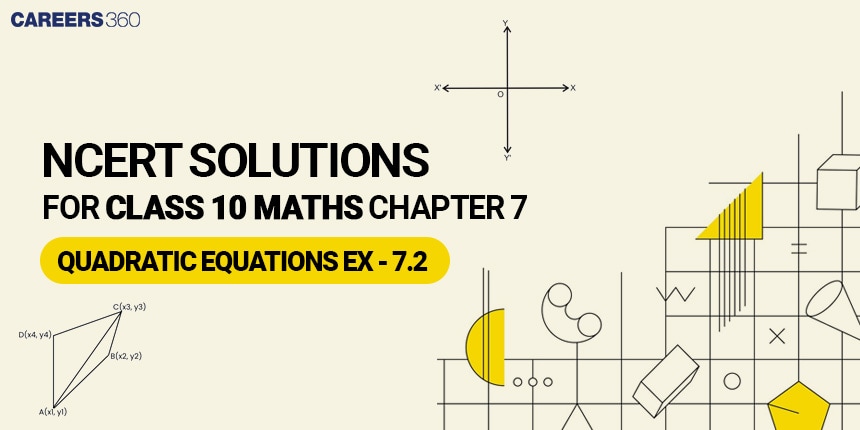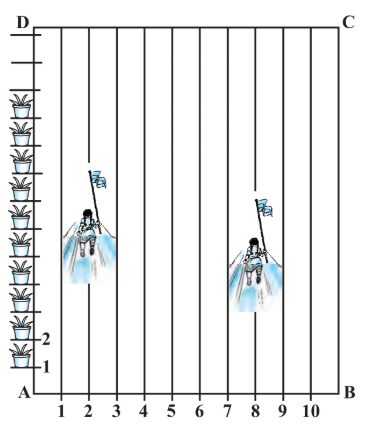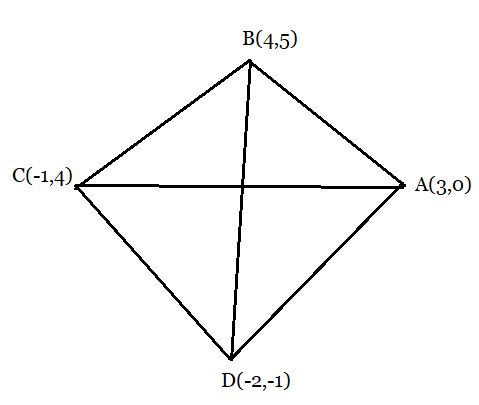NCERT Solutions for Exercise 7.2 Class 10 Maths Chapter 7 - Coordinate Geometry
CBSE Class 10th Exam Date:01 Jan' 26 - 14 Feb' 26
The section formula identifies its applications through the exercise of coordinate geometry. The exercise demonstrates how to calculate the point coordinates when dividing a line segment between two specified points by using a particular ratio. Students learn to find Cartesian plane positions when they solve these problems because such problems are essential foundations of basic geometric understanding. Knowledge about point positioning and their spatial relationships proves vital to tackle complex geometrical issues as well as identify certain spatial relations between points.
This Story also Contains
- NCERT Solutions Class 10 Maths Chapter 7: Exercise 7.2
- Access Solution of Coordinate Geometry Class 10 Chapter 7 Exercise: 7.2
- Topics covered in Chapter 7 Coordinate Geometry: Exercise 7.2
- NCERT Solutions of Class 10 Subject Wise
- NCERT Exemplar Solutions of Class 10 Subject Wise

The section in the NCERT Solutions guide for Class 10 Maths demonstrates how to apply the section formula that appears in the NCERT textbooks. The instructional material presents students with problems about line segment division, both internally and externally, together with problems about calculating midpoints and applications to real-world examples. Learners who study Exercise 7.2 of the NCERT Books reinforce coordinate geometry understanding while developing essential analytical and problem-solving abilities for advanced mathematics.
NCERT Solutions Class 10 Maths Chapter 7: Exercise 7.2
Access Solution of Coordinate Geometry Class 10 Chapter 7 Exercise: 7.2
Q1 Find the coordinates of the point which divides the join of (–1, 7) and (4, –3) in the ratio 2 : 3.
Answer:
Let the coordinates of point $P(x,y)$ which divides the line segment joining the points $A(-1,7)$ and $B(4,-3)$ , internally, in the ratio $m_{1}:m_{2}$ then,
Section formula: $\left (\frac{m_{1}x_{2}+m_{2}x_{1}}{m_{1}+m_{2}} , \frac{m_{1}y_{2}+m_{2}y_{1}}{m_{1}+m_{2}} \right )$
Substituting the values in the formula:
Here, $m_{1}:m_{2} = 2:3$
$\Rightarrow \left (\frac{2(4)+3(-1)}{2+3} , \frac{2(-3)+3(7)}{2+3} \right )$
$\Rightarrow \left (\frac{5}{5} , \frac{15}{5} \right )$
Hence the coordinate is $P \left (1 , 3 \right )$ .
Q2 Find the coordinates of the points of trisection of the line segment joining (4, –1) and (–2, –3).
Answer:
Let the trisection of the line segment $A(4,-1)$ and $B(-2,-3)$ have the points $P(x_{1},y_{1})$ and $Q(x_{2},y_{2})$
Then,
Section formula: $\left (\frac{m_{1}x_{2}+m_{2}x_{1}}{m_{1}+m_{2}} , \frac{m_{1}y_{2}+m_{2}y_{1}}{m_{1}+m_{2}} \right )$
By observation point, P divides AB internally in the ratio $1:2$ .
Hence, $m:n = 1:2$
Substituting the values in the equation we get;
$\Rightarrow P\left (\frac{1(-2)+2(4)}{1+2} , \frac{1(-3)+2(-1)}{1+2} \right )$
$\Rightarrow P \left (\frac{-2+8}{3} , \frac{-3-2}{3} \right )$
$\Rightarrow P \left (2 , \frac{-5}{3} \right )$
And by observation point Q, divides AB internally in the ratio $2:1$
Hence, $m:n = 2:1$
Substituting the values in the equation above, we get
$\Rightarrow Q\left (\frac{2(-2)+1(4)}{2+1} , \frac{2(-3)+1(-1)}{2+1} \right )$
$\Rightarrow Q \left (\frac{-4+4}{3} , \frac{-6-1}{3} \right )$
$\Rightarrow Q\left (0 , \frac{-7}{3} \right )$
Hence, the points of trisections are $P \left (2 , \frac{-5}{3} \right )$ and $Q\left (0 , \frac{-7}{3} \right )$

Answer:
Niharika posted the green flag at the distance P, i.e.,
$\frac{1}{4}\times100\ m = 25\ m$ from the starting point of $2^{nd}$ line.
Therefore, the coordinates of this point $P$ are $(2,25).$
Similarly, Preet posted red flag at $\frac{1}{5}$ of the distance Q i.e.,
$\frac{1}{5}\times100\ m = 20\ m$ from the starting point of $8^{th}$ line.
Therefore, the coordinates of this point Q are $(8,20)$ .
The distance $PQ$ is given by,
$PQ = \sqrt{(8-2)^2+(25-20)^2} = \sqrt{36+25} = \sqrt{61} m$
and the point at which Rashmi should post her Blue Flag is the mid-point of the line joining these points. Let this point be $R(x,y)$ .
Then, by Section Formula,
$P(x,y)= \left (\frac{m_{1}x_{2}+m_{2}x_{1}}{m_{1}+m_{2}} , \frac{m_{1}y_{2}+m_{2}y_{1}}{m_{1}+m_{2}} \right )$
$x = \frac{2+8}{2},\ y = \frac{25+20}{2}$
$x = 5,\ y = 22.5$
Therefore, Rashmi should post her Blue Flag at 22.5 m on the 5th line.
Answer:
Let the ratio be : $k:1$
Then, By section formula:
$P(x,y) = \left (\frac{kx_{2}+x_{1}}{k+1} , \frac{ky_{2}+y_{1}}{k+1} \right )$
Given point $P(x,y) = (-1,6)$
$-1 = \frac{6k-3}{k+1}$
$\Rightarrow -k-1 = 6k-3$
$\Rightarrow k = \frac{7}{2}$
Hence, the point $P$ divides the line AB in the ratio $2:7$ .
Answer:
Let the point on the x-axis be $P(x,0)$ and it divides it in the ratio $k:1$ .
Then, we have
Section formula:
$P(x,y) = \left (\frac{kx_{2}+x_{1}}{k+1} , \frac{ky_{2}+y_{1}}{k+1} \right )$
$\implies \frac{ky_{2}+y_{1}}{k+1} = 0$
$k =-\frac{y_{1}}{y_{2}}$
Hence, the value of k will be: $k =-\frac{-5}{5}= 1$
Therefore, the x-axis divides the line in the ratio $1:1$ and the point will be,
Putting the value of $k=1$ in section formula.
$P(x,0) = \left ( \frac{x_{2}+x_{1}}{2}, 0 \right )$
$P(x,0) = \left ( \frac{1-4}{2}, 0 \right ) = \left ( \frac{-3}{2}, 0 \right )$
Answer:
Let the given points $A(1,2),\ B(4,y),\ C(x,6),\ D(3,5)$ .
Since the diagonals of a parallelogram bisect each other. Intersection point O of diagonal AC and BD also divides these diagonals.
Therefore, O is the mid-point of AC and BD.
The coordinates of the point O when it is mid-point of AC.
$\left ( \frac{1+x}{2}, \frac{2+6}{2} \right ) \Rightarrow \left ( \frac{x+1}{2}, 4 \right )$
The coordinates of the point O when it is mid-point of BD.
$\left ( \frac{4+3}{2}, \frac{5+y}{2} \right ) \Rightarrow \left ( \frac{7}{2}, \frac{5+y}{2} \right )$
Since both coordinates are of same point O.
Therefore,
$\frac{x+1}{2} =\frac{7}{2}$ and $4 = \frac{5+y}{2}$
Or,
$x = 6\ and\ y = 3$
Answer:
As the centre point $C(2,-3)$ will be the mid-point of the diameter AB.
Then, the coordinates of point A will be $A(x,y)$ .
Given point $B(1,4)$ .
Therefore,
$(2,-3) = \left ( \frac{x+1}{2}, \frac{y+4}{2} \right )$
$\frac{x+1}{2} = 2\ and\ \frac{y+4}{2} = -3$
$\Rightarrow x = 3\ and\ y = -10$ .
Therefore, the coordinates of A are $(3,-10).$
Answer:
From the figure:

As $AP = \frac{3}{7}AB$
$\Rightarrow PB = \frac{4}{7}AB$ hence the ratio is 3:4,
Now, from the section formula, we can find the coordinates of Point P.
Section Formula:
$P(x,y)= \left (\frac{m_{1}x_{2}+m_{2}x_{1}}{m_{1}+m_{2}} , \frac{m_{1}y_{2}+m_{2}y_{1}}{m_{1}+m_{2}} \right )$
$P(x,y)= \left (\frac{3(2)+4(-2)}{3+4} , \frac{3(-4)+4(-2)}{3+4} \right )$
$P(x,y)= \left (\frac{6-8}{7} , \frac{-12-8}{7} \right )$
$P(x,y)= \left (\frac{-2}{7} , \frac{-20}{7} \right )$
Answer:
From the figure:

Points C, D, and E divide the line segment AB into four equal parts.
Now, from the section formula, we can find the coordinates of Point C, D, and E.
Section Formula:
$P(x,y)= \left (\frac{m_{1}x_{2}+m_{2}x_{1}}{m_{1}+m_{2}} , \frac{m_{1}y_{2}+m_{2}y_{1}}{m_{1}+m_{2}} \right )$
Here point D divides the line segment AB into two equal parts hence
$D(x_{2},y_{2})= \left (\frac{-2+2}{2} , \frac{2+8}{2} \right )$
$D(x_{2},y_{2})= \left (0 , 5 \right )$
Now, point C divides the line segment AD into two equal parts hence
$C(x_{1},y_{1})= \left (\frac{-2+0}{2} , \frac{2+5}{2} \right )$
$C(x_{2},y_{2})= \left (-1 , \frac{7}{2} \right )$
Also, point E divides the line segment DB into two equal parts hence
$E(x_{1},y_{1})= \left (\frac{2+0}{2} , \frac{8+5}{2} \right )$
$E(x_{2},y_{2})= \left (1 , \frac{13}{2} \right )$
Answer:
From the figure:

Let the vertices of the rhombus are:
$A(3,0),\ B(4,5),\ C(-1,4),\ D(-2,-1)$
Area of the rhombus ABCD is given by;
$= \frac{1}{2}\times(Product\ of\ lengths\ of\ diagonals)$
Hence we have to find the lengths of the diagonals AC and BD of the rhombus.
The distance formula:
$D = \sqrt{(x_{2}-x_{1})^2+(y_{2}-y_{1})^2}$
Length of the diagonal AC:
$AC = \sqrt{(3-(-1))^2+(0-4)^2} = \sqrt{16+16} = 4\sqrt{2}$
Length of the diagonal BD:
$BD = \sqrt{(4-(-2))^2+(5-(-1))^2} = \sqrt{36+36} = 6\sqrt{2}$
Thus, the area will be,
$= \frac{1}{2}\times (AC)\times(BD)$
$= \frac{1}{2}\times (4\sqrt{2})\times(6\sqrt{2}) = 24\ square\ units.$
Also Read,
Topics covered in Chapter 7 Coordinate Geometry: Exercise 7.2
1. Section Formula: The section formula allows one to discover coordinates by dividing a straight line segment with a defined ratio.
2. Internal and External Division: Students must solve problems concerning line segment division when they involve internal and external divisions of these segments.
3. Mid-Point Formula: The section formula provides a method for determining the midpoint position between two points based on coordinate systems.
4. Real-Life Applications: The section formula finds real-world uses for practical problems that include determining positions in sports fields and construction layouts.
5. Analytical Geometry Skills: Using Analytical Geometry skills helps students improve their abilities to analyse geometrical problems by working with coordinates.
Check Out-
NCERT Solutions of Class 10 Subject Wise
Students must check the NCERT solutions for class 10 of the Mathematics and Science Subjects.
NCERT Exemplar Solutions of Class 10 Subject Wise
Students must check the NCERT Exemplar solutions for class 10 of the Mathematics and Science Subjects.
Frequently Asked Questions (FAQs)
There are 10 questions within the NCERT solutions for Class 10 Maths chapter 7 exercise 7.2 .
Solution :
Internal section formula
External section formula
The section formula is the formula that is used for finding the midpoint of a line segment.
A point P(x,y) divides the line segment AB into two segments in the ratio m:n. m is the ratio in dividing the line segment.
When a point on the line segment divides into two segments, then the section formula is used to determine the coordinates of that point.
When some extent P(x,y) divides the segment into two segments, with marked points as A (x1,y1) and B(x2,y2) then the formula which is employed to work out the coordinates of that time is understood because of the section formula.
Questions related to CBSE Class 10th
On Question asked by student community
The CBSE Sahodaya Question Papers for Class 10 (2025-26) are not released centrally by the board as a single PDF.
Here is the essential information you need:
-
Local Release: The papers are designed and released by the individual Sahodaya School Clusters (groups of CBSE schools) just before or during the pre-board exam dates (typically held in December and January). Therefore, you must check your local cluster's portal or directly with your school administration.
-
Best Practice: The official model papers, based on the full 2026 syllabus, are the most reliable tool for practice. These accurately reflect the structure, format, and competency-based questions used in the Sahodaya exams.
You can download the latest CBSE Class 10 Model Papers to simulate the Sahodaya tests here: https://school.careers360.com/articles/sahodaya-question-paper-2025 . Focus on that pattern
Hi! If you’re looking for the Class 11 English half yearly question paper for 2025-26 (CBSE board), you’ll find the right resource once you check the link provided from Careers360. Solving previous or sample papers is a smart way to prepare, as it helps you understand the question types, marking scheme, and important topics. This practice will boost your confidence and help you manage your time well in the actual exam.
https://school.careers360.com/boards/cbse/cbse-class-11-half-yearly-sample-papers-2025-26
Hi dear candidate,
Could you please specify us the board of education for which you need the half yearly question papers of class X so that we can help you further.
Below are few links which may help you and it has all the subjects with English as well:
CBSE Class 10 Half Yearly Exam Question Paper 2025-26 with Answer Key & Analysis
ICSE Class 10 Half Yearly Sample Papers 2025-26 PDF (All Subjects)
BEST REGARDS
Hi dear candidate,
Can you please specify the board of education or state for which you need to know the exam pattern and syllabus so that we can guide you accordingly.
Since, most of the boards uses NCERT as base syllabus, you can refer to the link below:
NCERT Syllabus for Class 10 – All Subjects PDF Download 2025-26
Exam pattern:
CBSE 10th New Exam Pattern 2026- Marking Scheme, Subject-Wise Exam Pattern
BEST REGARDS
The CBSE Class 10th Board Exams for the 2026 session will follow the revised curriculum, emphasizing competency-based questions.
-
Conducting Body: Central Board of Secondary Education (CBSE).
-
Exam Period: The main theory exams are typically held between February and April 2026.
-
Grading: Based on marks in five main subjects plus internal assessment marks (often 20 marks per subject) provided by the school.
-
Passing Criteria: You must achieve at least 33% overall in each subject (theory + practical/internal assessment combined) to be declared pass.
Key Preparation Strategy
The most crucial element of your preparation is understanding the exam structure:
-
Syllabus: Strictly adhere to the rationalized syllabus released by CBSE for the 2025-26 academic year.
-
Practice: Your primary resource should be the latest sample papers and previous year question papers. These accurately reflect the format and types of competency questions being asked.
For the most comprehensive and official announcements, including the detailed time table and access to crucial practice materials, always check the official board updates, as tracked by Careers360: https://school.careers360.com/exams/cbse-class-10th .
Applications for Admissions are open.
As per latest syllabus. Physics formulas, equations, & laws of class 11 & 12th chapters
JEE Main Important Chemistry formulas
Get nowAs per latest syllabus. Chemistry formulas, equations, & laws of class 11 & 12th chapters
JEE Main high scoring chapters and topics
Get nowAs per latest 2024 syllabus. Study 40% syllabus and score upto 100% marks in JEE
JEE Main Important Mathematics Formulas
Get nowAs per latest syllabus. Maths formulas, equations, & theorems of class 11 & 12th chapters
